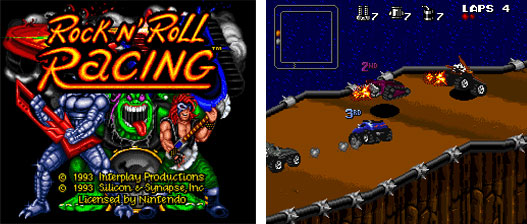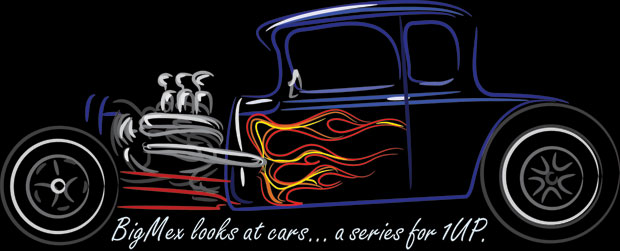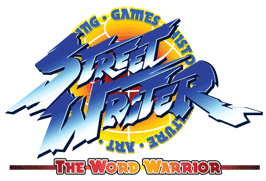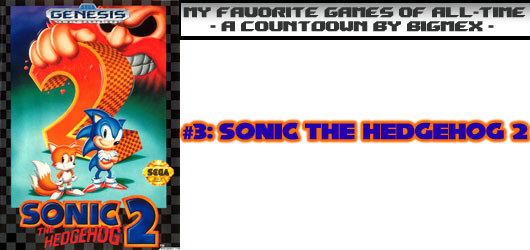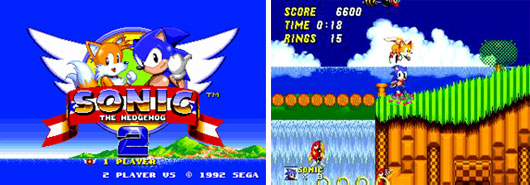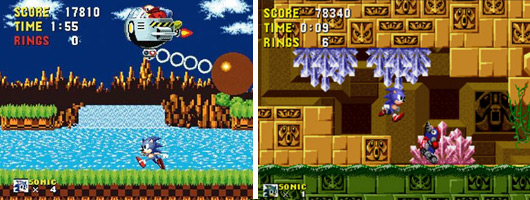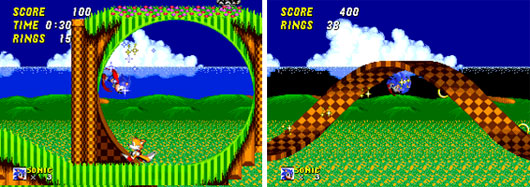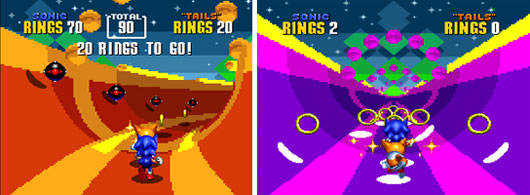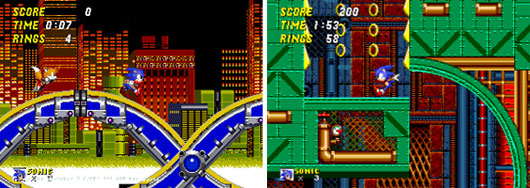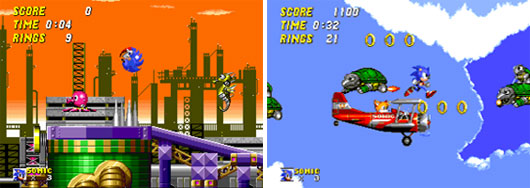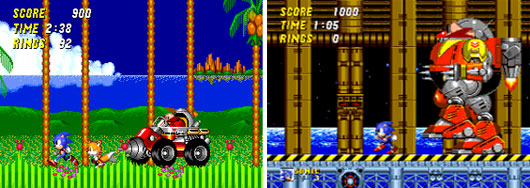Maui Mallard in Cold Shadow had a specific theme that was evident as soon as the game started. The fonts and colors used in the menus and story screens harkened back to classic Hollywood. The
was punctuated by crisp lines, sharp angles and stylized lettering.

The cool blue and black color motifs featured in the menu and story screens helped create a noir feel. The addition of an island setting and related theming added a
tiki atmosphere over the entire title. The combination of noir and tiki gave the game a unique style, possibly one that will never be matched. This blog will cover the various versions of the game including the PC, Super Nintendo and Sega Mega Drive (the name for the Genesis console in Japan and the UK) versions but not the horrid
GameBoy version.

The game set the tone right away, the opening story and all cut scenes were hosted by a detective named Maui Mallard. The laid-back private investigator was working on a case of a missing idol named Shabuhm Shabuhm. The natives believed that the idol was sacred and without it the entire island would destroy itself within a day. The set up was typical of most adventure games, recover an item, avoid some traps, fight some bosses and save the day. It was the levels and supporting cast that made the experience memorable. The design of Maui for example, the red Hawaiian shirt and blue baseball cap were based very much on the popular
Magnum PI, the TV detective played by Tom Selleck.

Since Maui was a detective working a case against mysterious forces then he had to be armed. Yet giving a Disney icon a gun in a game would not have been acceptable to audiences. Thankfully this was not Donald but some distant cousin named Maui. But even then it was not enough to appease worried parents. There had been a precedence for having Disney hero with a firearm previously. The character Darkwing Duck had a gun that shot sleeping gas. It seemed to be an acceptable firearm for afternoon TV cartoons.

Disney Interactive gave Maui a gun that shot bugs instead of bullets. Since Maui did not have any melee attacks then the gun had to have to be good up close as well as at range. Plus this weapon had to be accessible while climbing, jumping or even swimming underwater! Animators did a great job at allowing Maui to move freely across the levels, climb and drop while still being able to shoot from his pistol. The oversized gun would not be mistaken for a real firearm because the proportions and even color were over-the-top. Moreover the speed of the bug bullets were slowed for player to track them across the screen.
In the Genesis and PC versions the player could shoot the weapon with an unlimited supply of regular bug ammo. The SNES version would recharge if all 50 default shots had been expired. The bugs themselves, giant beetles, became a unique ammunition type that helped expand the gameplay. In addition to unlimited bug shots the player could find fire, lightning and exploding bugs hidden in the stages. These bugs could deal more damage or even seek out opponents. These bug types could also be combined for different results; a fire and lightning bug would cause a homing electric spark, an exploding bug with a fire bug would yield a multiple burst flame shot. If all three additional bug ammo types were used then a flash would wipe out all the opponents on the screen.

A rare fourth bug, a light bug, could not be fired from the gun but could illuminate dark corridors or hidden paths on certain levels. It was a unique effect that was featured more in the early stages of the SNES version of the game than the PC and Genesis builds. It made the macabre first level of the game, the Mojo Mansion, even creepier.
There were some similarities between the versions aside from the bug gun. Our hero had a health meter that could be built above 100% by collecting magical talismans as well as by drinking Power Punch. To keep things consistent with the island theme there were glasses and pitchers of a bright red tropical punch located all over the island.
The game was lighthearted but it also had a creepy tone to it. The artistic direction was far more mature for a Disney title than the usual kid-fare. The design was gothic but not too grotesque, at least everything prior to the zombie parts. The main characters had more of the irreverence of the classic Disney park attractions like Pirates of the Caribbean and the Haunted Mansion.
Maui might have taken a cue from Magnum PI but the design of the character and this universe had more in common with the tone, humor and style of
Quack Pack than the classic
Duck Tales. Even the color and design of the Hawaiian shirt was an opposite of the shirt Donald wore in the Quack Pack series. Maui Mallard could be considered the book-end to the classic Capcom side scroller Duck Tales. It was one of the greatest 8-bit console games ever made. The game, animation and music all helped shape the memories of an entire generation. Although it lacked the same impact Maui Mallard in Cold Shadow was one of the greatest 16-bit games ever created. It had advanced music, animation and level designs that reflected the changing tastes of the audience as well as the technology.

Not convinced that there could be such a thing as an adventurous and macabre adventure for Maui? Then perhaps the reader should listen intently at the music featured in the first level,
the Mojo Mansion, written by Michael Giacchino (yes the Academy Award-winning movie composer) and Patrick J. Collins. The trail of the idol Shabuhm Shabuhm lead players to the first level in the game, an enormous mansion layered with atmosphere, secret panels, statues, ghastly butlers, poltergeists and giant spiders. In the song players can hear all sorts of fun sound effects and clever musical ideas. There were many differences between the console and PC versions of the game. The only way to truly appreciate the vision that the team at Disney Interactive was going for would be to try both console builds (and if possible the PC version) and see what elements each preserved.
The SNES version had brighter and more contrasting colors on the sprites whereas the Genesis version had more animations and details which made it closer to the PC version. For example hidden monsters inside the butler's serving tray, while hinted at in the cinemas on the SNES side, only appeared in the Genesis and PC versions. Poltergeists in the walls, ectoplasm spitting tiki masks and other minor details also appeared in the Genesis and PC versions but not the SNES build. It was not known if this was to tone down the creepiness or because the publisher didn't have time to put those details into the Nintendo cartridges. Each console version had a scaled-down soundtrack with a few digitized voices but by far the PC soundtrack was the best of the three versions.

Each version of the game was unique and had many themes which balanced the elements featured across the title. The Mojo Mansion layout and puzzles were slightly different between the Genesis and the SNES but neither could really be called superior.
Where the Genesis and PC builds were vastly different were in the animation and especially with the often darker bosses. The boss character for the Mojo Mansion was a giant mechanical spider. It looked menacing in the SNES version but was downright scary in the Genesis build. It moved faster and provided much more of a challenge.
Gamers that defeated the boss and did well on a level got a chance to do a bonus game titled Babaluau Baby. This level allowed players the chance to gain an extra life, a continue or magical properties for Maui's alter ego. The SNES version required players to get a certain percentage of hidden treasure before being whisked away to a giant theater stage.
Players had to collect all the hidden dancing tiki idols before time ran out in the bonus level. Grimacing suns and goofy moons hanging from the rafters provided the platform for gamers to jump on. A successful play through of each Babaluau level could only be achieved if players were careful with each leap. Otherwise they would end up falling to the floor and have to start climbing through the stage again. Players had to launch fireworks attached to the suns and moons within two minutes or else all of the bonus items they collected would be forfeit. Afterward the gamers would be rewarded with a level code which allowed them to restart a stage with all their saved items.

Reaching the Genesis and PC versions of the Babaluau stages had a completely different requirement. Instead of tracking down all the treasure in the regular stages players had to shoot a specific villain before it could run away. This character would drop a golden ticket. If gamers didn't catch the ticket as it fell then the game would skip past the Babaluau level at the end of the stage.
The Genesis / PC version of the bonus stage had a completely different gameplay mechanic. The level was still based on a giant theater stage and the cloud, sun and moon props were everywhere. Maui was not timed while searching for bonus items and there were no fireworks to launch. The lack of a time clock was a blessing. Instead Maui was given four different bonus items, small golden tiki idols of different shapes right at the start. Players had to avoid getting hit while navigating to the exit in order to keep these bonus items.
To make things interesting Maui was riding a unicycle on a bamboo roller coaster track and could only go left, right and jump. He lost one item for each time he was hit and the level ended if he fell through a platform before reaching the end of the track. It was undoubtedly one of the hardest but most memorable bonus stages in console history.
The Genesis and PC versions of this level had characters mentioned in the SNES material but which never actually appeared in the game. These were the Amazon Ducks and Fire Juggling Drakes. The Amazons could knock Maui around with a slap from a large wooden shield. They would send him to different tracks but not take any items, if Maui got hit with a torch however he would lose a bonus item.

As the story progressed Maui decided that the secrets within the Mojo Mansion were hiding something far more sinister, it was time to take off the gloves. He went to explore the mystery of Shabuhm Shabuhm in the ruins of a lost city dubbed the Ninja Training Grounds. After the first bonus level the game changed pace. Maui’s alter ego, Cold Shadow was finally allowed to take center stage. While exploring the ruins of the Training Grounds Maui came across an evil Witch Doctor. This point in the game was the second time that the weather became an important background detail. In the Mojo Mansion some gale force winds made it difficult for Maui to advance outside of the mansion. In the Training Grounds the sky was blue and sunny while as Maui but as soon as the Witch Doctor showed up storm clouds appeared and lighting cascaded in the distance. Environmental effects were not a new thing in console gaming but were rarely seen. In a few points through the game the weather set the mood and increased the challenge for players.
The tiki-masked Witch Doctor striped the ninja spirits out of Maui. At some point in his past Maui had been trained in the martial arts but had given up his fighting ancestry to pursue a new life as a detective. What a great back story! Anyhow the evil with doctor scattered the ancient ninja spirits across the levels. Maui would now have to collect Yin Yang Coins in order to have enough energy to summon his alter ego. When players accomplished this they would trigger his transformation with a button combination. Maui spun in place and changed his clothes, stance and personality. The ninja Cold Shadow ran on spirit coins and had a countdown meter in the Genesis / PC builds. Once out of energy Cold Shadow reverted back to Mallard. In the SNES version the coins did not count down except for when the player performed a combo attack.

The Ninja Training grounds served as a playground to give gamers a chance to explore the full range of attacks and abilities as Cold Shadow. It was a different experience altogether from playing as Maui Mallard. The stages in the game were designed to offer each character a unique challenge, neither Maui nor Cold Shadow could complete a level without the aid of all of the others' character moves.
Players had to defeat the various ninja ducks scattered across the island, each one representing a spirit that Maui was stripped of. The other ninja ducks could perform almost the same attacks as Shadow. They tiptoed across the levels with bo-staff in hand and struck as fast as the player could. Some had different colored belts and others different colored outfits.
An interesting detail missing in the Genesis build was the color-changing belt on Shadow. In the SNES version Cold Shadow’s belt changed color with the more yin yang coins he got. Like traditional martial arts belt-ranking systems, the belt changed colors from white to yellow to red and brown until he reached black belt status.
As if having two distinct character options for our hero wasn't enough there was a third option that could be played as in certain stages. If Maui defeated a series of straw-built sparring partners then he could command a gigantic stone duck monument. The juggernaut was slow and unstoppable, plowing through walls and allowing our hero to get to places previously blocked off. Unfortunately the player could not keep this character for long, once he walked to the other sides of the level the statue would stop and spit out our hero.
Cold Shadow fought in a completely different way than Maui. He had only melee attacks and had to be relatively close to opponents in order to beat them. The other ninja ducks seem impervious to the bug bullets of Maui so players were forced to get up close and fight them. The staff attacks could do much more damage than the bug ammo in any regard. From this point forward Maui could transform back and forth into Cold Shadow on almost every stage with the exception of the bonus levels.

Cold Shadow could navigate the levels in unique ways. He could leap further and run faster than Maui. There were also idols scattered around the Training Grounds that he could grapple onto and swing from using his staff. This allowed players to avoid spike pits and bottomless chasms. It also allowed Cold Shadow to swing into higher platforms and locate hidden items. The best 16-bit games allowed for more than one gameplay mechanic. Earthworm Jim was not only about the running and gunning. The game also allowed the hero to swing from location to location in a seamless fashion. The SNES swinging mechanic for Cold Shadow was far more forgiving than the Genesis build and almost as good as the Earthworm Jim one.
Where Disney Interactive exploited a new mechanic for a platform game was where Cold Shadow could climb vertically using his bo and some well timed jumps. The “Salmon Ladder” climbs were unique and not entirely easy to perform. Timing was important when climbing. Players could accidentally let go before leaping and end up dropping, or wait too long to extend the pole after a jump and end up staying in place. Additionally some of the walls would break away and cause our hero to tumble back down a shaft. Timing became very important in order to progress through the game. Thankfully the team at Disney Interactive made sure the use of the climbing mechanic never felt labored. A little bit of practice went a long way in the game and the Ninja Training Grounds made sure that audiences memorized the moves of Cold Shadow before the boss battle.

The bo staff as a weapon and means of navigation was something that helped keep the stages unique and made the character memorable. Navigating a level in unique ways was a staple for the best titles. The triple jump, wall jump and grappling hook were some ways that other developers beat the old run and jump titles.
At the end of the Ninja Training Grounds our hero had to fight waves of ninjas in front of a large statue. The altar of an ancestral fighting duck released explosives, ninjas and tropical punch in equal measure.
Once the ninjas were defeated Maui was confronted by a large floating orange globe. It released a leggy duck named Herneae in a flash of magical energy. It was the "dame" that Maui mentioned in the game manual and the person that put Maui on the trail of Shabuhm Shabuhm.
She was more than just another pretty face. The High Mojo Sorceress told Maui that there was a legend that foretold of a great warrior that would help save the natives. She assumed it was not Cold Shadow so he was warned him to stay out of the way. She disappeared back into the magical orb and flew away. Our hero was not dissuaded and followed the trail of Shabuhm Shabuhm deeper into the jungle.

The next level took our hero into the middle of the Muddrake village. These tiny native ducks, called the Muddrakes, were equal parts fearsome warrior and comedic classics. Easily the scene stealers in the game the natives leapt at Maui with reckless abandon. They would scream “There he is!” and “Get him” at the top of their lungs. They attacked Maui with an arsenal of weapons. Blow darts, boomerangs and buzz saw yo-yos. They would use these when they weren’t trying to dog pile on Maui. If Maui could get a shot on them then they might lose their shorts, leaving the tiny natives feeling rather embarrassed.

Our hero was allowed to explore levels made up of straw huts, muddy slopes, piranha infested waters. The leader of the Muddrakes, a shaman wearing a skeleton headdress delighted in turning our hero into a miniature version of himself. The magic was even powerful enough to shrink down the Bug Gun. This diminutive Maui was scaled smaller than even the already short Muddrakes. In this form however he could enter their huts and even fight through the tunnels left by giant wasp larvae.
In the Genesis / PC versions our hero could fight the worms but they were nonexistent in the SNES version. Also Maui could not turn into Cold Shadow when in miniature format. For those keeping score this was the fourth unique type of character that Maui could turn into. The gameplay and level design changed based on which element was applied to the character.
These constant changes to the gameplay helped keep the overall experience fresh and unique. Disney Interactive was demonstrating to gamers that it understood the diversity of gameplay styles that appealed to audiences. Platformers had expanded greatly since the days of the Mario Bros. Earthworm Jim was considered the peak of the format to most console players but by the second stage in this game Disney was giving Shiny Entertainment a run for their money. Maui Mallard played up the elements of great design and control while injecting a good deal of the irreverence and comedy that made Earthworm Jim work so well.
The boss battle in Muddrake Mayhem was located inside or a tiki coliseum. Maui found himself surrounded by Muddrakes cheering on the spectacle. A half dozen Muddrakes hiding behind gigantic mask would throw spears and use blow darts against our hero. Attendants would throw out bonus ammo or even Power Punch to help even the odds. The SNES version of this level was very minimalistic, with just one row of Muddrakes cheering or doing the “wave” whereas the Genesis / PC build had multiple rows of spectators cheering and bringing up sign cards taunting Maui.

If players survived several waves of the Muddrakes then he would be rewarded for proving his bravery. In traditional format the bravest warrior was thrown into a live volcano as a sacrifice. The challenges and levels would only get harder and more unique as the game progressed. We shall explore these in the next blog. If you would like to sponsor me
please visit my Patreon page and consider donating each month, even as little as $1 would help make better blogs and even podcasts!